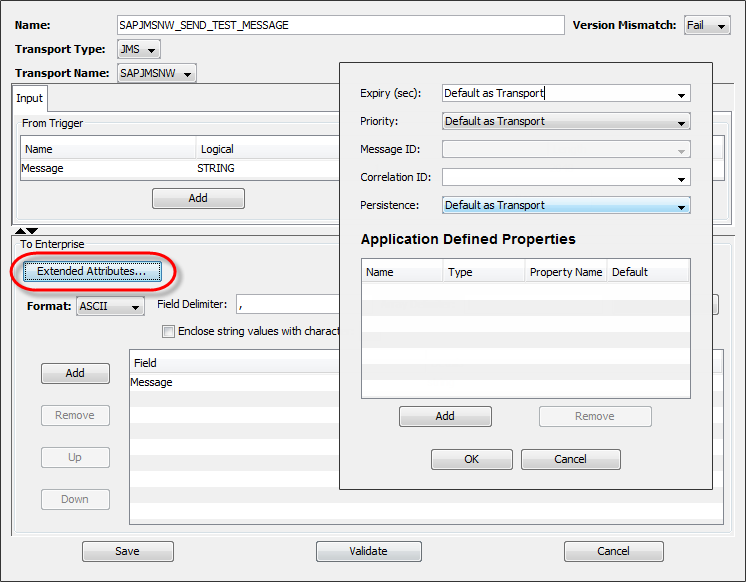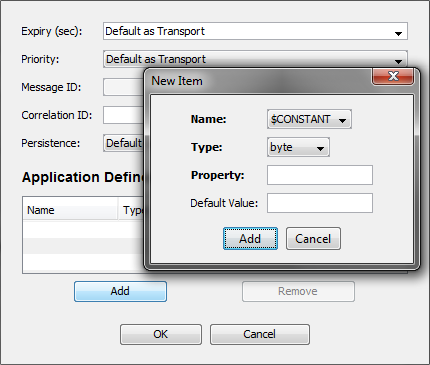In the JMS transport map, you can override some of the JMS extended attributes of the message that are set by the transport. The protocol specific context information that can be updated in the message header includes:
- Correlation ID
- Priority, Persistence, Expiry
- Application specific header properties that may be required by the enterprise application receiving the message
When you specify extended attributes at the transport level, all trigger and transport map pairs using that transport will have the same extended attribute settings.
You can specify extended attributes in the transport map to have more control over the JMS header content of messages sent to the endpoint enterprise application program using this transport map. The extended attribute configuration in the transport map overrides any configuration specified in the transport.
The following assumes that you have specified a JMS
transport for the transport map and created an
Input tab and added one of the supported
payload types. The extended attributes panel is accessed
from the transport map definition panel which displays an
Extended Attributes button if the
transport map is defined for a WebSphere MQ or JMS
transport.
When you select the Extended Attributes
button, a popup panel as shown is displayed:

| Parameter | Description |
|---|---|
| Expiration | This is a combination field and list box. If left unspecified as indicated by Default As Transport, then the JMS message created by this transport map will be initialized with the expiration specified on the transport. Otherwise, enter a numerical value that represents the time to live for the message in seconds. You can select Unlimited from the list to indicate that the message has an infinite time-to-live. |
| Priority | This pick list specifies the priority of a JMS message defined by this transport map. Choose a value from 0 (Lowest) through 9 (Highest). If left unspecified as indicated by Default As Transport, then this JMS message will have a priority as specified on the transport. |
| Correlation ID | This is the correlation
ID that will be set in the JMS
message defined by this transport map.
The default is to not set the
Correlation ID. This can be a constant value specified in the transport map or a value passed in by the trigger by using the Input tab. |
| Persistence | This pick list can be used to specify the JMS delivery mode (persistence) of the JMS message defined by this transport map. If left unspecified as indicated by Default As Transport, then the JMS message created by this map will be initialized with the Delivery Mode specified on the Transport. The other options are Persistent or Non-Persistent. |
Application Defined Properties
Use this section of the Extended Attributes panel if your enterprise application expects user defined JMS Header properties to be added to a JMS Message defined by this transport map. You specify the value one property at a time by selecting the Add button and entering the property information in the popup panel.

| Parameter | Description |
|---|---|
| Name | Specify the value to be used in the
JMS header property. Select one of
|
| Property | Specify the key value of the Application defined JMS Header property in this field. This JMS Header property will be present in the JMS message defined by this transport map. |
| Type | This pick list specifies the data type of the JMS Header property. The data type is typically dictated by the target business application consuming this JMS Message. The type information is used to call the appropriate JMS Header property setter when adding the JMS Header property to the JMS Message defined by this transport map. |
| Default Value | Specify a value in this field if you selected $CONSTANT in the Name field. The value entered here will be the value of the JMS Header property added to the JMS Message defined by this transport map. Enter a value appropriate for the type specified. If an error occurs when setting the JMS Header property the transport will fail the request. |
Related topics
Defining an ASCII message payload
Creating a payload of freeform text